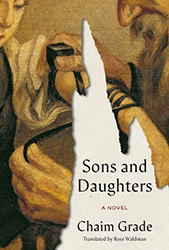During the nineteenth and early twentieth centuries, Yiddish emerged as a primary literary language for a rising generation of writers and intellectuals in small towns and cities in Eastern Europe, but moreso, in the vibrant Jewish cultural center of Warsaw. Hersh Dovid Nomberg (1876−1927) was an important figure during this physical and spiritual transition. Raised in a Hasidic family in Mszczonow, Poland, Nomberg rejected his ultraorthodox roots and moved to secular Warsaw at the age of twenty-one. He was a younger member of the coterie of writers around the charismatic Y. L. Peretz (which included Sholem Asch). Nomberg also played an important role in the famous Czernowitz Conference in 1908, where a host of major writers gathered, declaring Yiddish “a national language” of Jews in the diaspora, a proclamation Nomberg himself authored.
Very little of Nomberg’s literary work, which includes poetry, plays, novels, and journalism, is available in English. But thanks to the Yiddish Book Center’s new publishing imprint, White Goat Press, and Daniel Kennedy’s superb translation, we can now rediscover Nomberg’s poignant, unsettling, and deeply moving stories about uprooted Jews. Warsaw Stories invents a landscape inhabited by young Jews in flight from tradition, betwixt and between worlds, at home nowhere, dreaming, swindling, gossiping, masquerading, rebelling, yearning, overcome with rage and shame, and above all, feeling lost in a disorienting urban landscape.
Nomberg’s most famous character is Fliglman, or “wing man,” a young man in “flight” who appears to be the author’s alter-ego. He receives both Nomberg’s empathy, but is also the object of substantial (self) satire: “His eyes looked like they were fogged up with steam, as if all one needed to do was wipe them with a handkerchief for them to shine brightly.” Fliglman is a romantic with high expectations and precise requirements for his romantic life. “No shallow soul would ever be capable of loving him,” Fliglman determines, but he remains clueless about the shallow dimension of his dreamy philosophizing, or his avoidance of female relationships. In the end, Fliglman looms as one of Nomberg’s unmoored comic souls, “an apostate” in the eyes of his family, perceived as “pathetic” by a would-be lover. He lives with an elevated view of himself, oblivious to “his lonely life,” a lost soul who “spiraled in an empty void.”
Perhaps an even thicker portrait of a new Jewish generation is on display in “Higher Education.” In this fascinating story, we meet Lyuba Fidler, a young woman of “sad, clear eyes,” deep powers of observation, and fiery political commitments. Fidler moves between a world of weary bourgeois complacency and unearned comfort — represented by a potential love interest in the politically apathetic Dr. Vaynshteyn — and her own committed revolutionary identity, which becomes temporarily softened when Fidler becomes a tutor for the doctor’s young nephew. Fidler’s complex reactions to this unsavory bourgeois world enables Nomberg to explore a range of extreme behaviors, above all, rage and shame. Fidler feels rage at the prospect of being part of Vaynshteyn and his parvenu sister-in-law’s world, “but the shame she felt in front of her friends and her own conscience, that was the most terrible thing of all.” “Higher Education” ends with a shocking epilogue; Fidler, we learn, keeps faith with her stern political religion, which harbors a latent murderous violence. In response to hearing of Fidler’s fate, Dr. Vaynshteyn becomes “numb” — he will forever be haunted by dreams “of bombs and carnage, of gallows and stiff human bodies shaking in the wind.” Such is Nomberg’s bleak vision, shorn of any human illusion.
Virtually all the characters in Warsaw Stories live “muddled” lives, for they remain tangled up in the webs of modern Jewish history. Nomberg’s genius comes from his ability to register the psychic and emotional valences of this bewildering liminal moment at the turn of the century: to imagine characters struggling in modernity. A number of stories, narrated in the first person, convey the dilemmas and ironies of a Jewish self in masquerade, performing an identity. In “In a Hasidic House,” for example, the “Litvak” narrator (someone of a more rational, less religiously demonstrative bent) becomes obsessed with a young woman imagined as pious, the so-called modest daughter of a wealthy Hasidic family. In the end, the narrator has a soul-transforming epiphany. Confronted by a shocking revelation (many of Nomberg’s stories end with mind-bending revelations), the narrator confesses: “I felt, then and there, that I had lost something very dear and important, something I might never get back.”
In this respect, Nomberg’s characters remain emotionally afflicted. Some nostalgically weep in memory of the loss of religious ritual and tradition (“Neighbors”), others have a chronic, obsessive need to dwell on the state of one’s soul (“Letters”); some are immobilized by an orbiting melancholia (“Roommates”), others are made insane by fantasies of quick and easy wealth (“The Golden Fantasy”).
Nomberg’s fascinating portrait of Jewish life in the early twentieth century may be dark, but his imagination of shadow and despair, of anger and bewilderment, of madness and revolutionary fervor, flows from the landscape of partial assimilation that his characters uneasily inhabit. The newly-arrived Jews of Warsaw Stories, fresh from the shtetls of Eastern Europe, are a richly-drawn, recognizable people in motion, caught in the web of modernity. Hopefully, we will soon have more Nomberg available in translation, so we can learn more about the career and vision of this neglected, but important Jewish writer, who emerged on the global literary scene a century ago.
Donald Weber writes about Jewish American literature and popular culture. He divides his time between Brooklyn and Mohegan Lake, NY.





